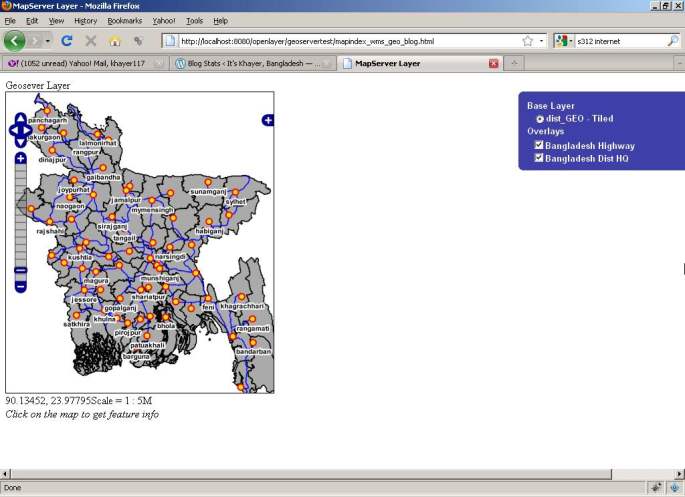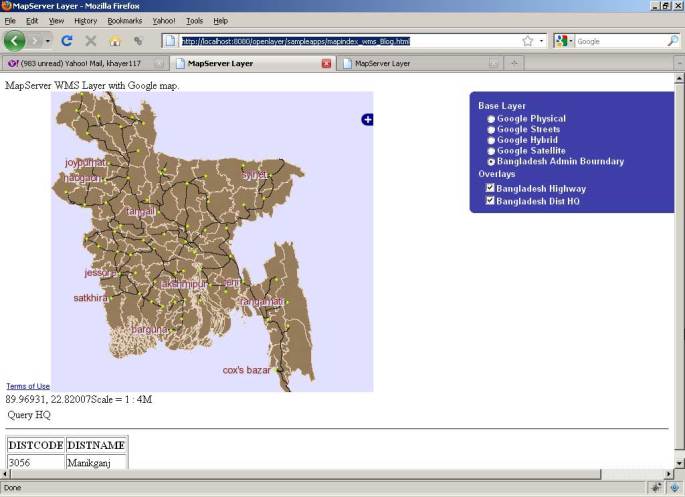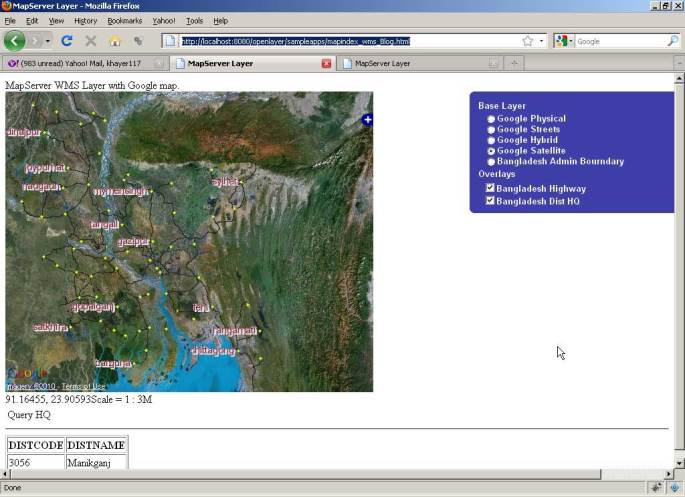GeoSever is very good map repository. It supports most of the request including WMS. Open layer work well with Geoserver. Here I try to give a sample to use openlayer with Geoserver especially for beginner.
Add MapSever WMS Layer:
The main goal is that we will add geoserver layer as wms in the open layer. So the layer definition should be,
var dist = new OpenLayers.Layer.WMS(
"dist_GEO - Tiled", "http://localhost:8088/geoserver/wms",
{
srs: 'EPSG:4326',
width: '395',
styles: '',
height: '512',
layers: 'bdadmin:dist_GEO',
format: format,
tiled: 'true',
tilesOrigin : map.maxExtent.left + ',' + map.maxExtent.bottom,
isBaseLayer: true,
visibility: true
},
{
buffer: 0,
displayOutsideMaxExtent: true
}
);
This will include Bangladesh district boundary as base wms layer. Note that we set the srs value wgs84 projection of our data. The example geoserver is running on 8088 port.
Now we add the road layer from wms as openlayer overlay layer.
var bdhw = new OpenLayers.Layer.WMS(
"Bangladesh Highway",
"http://localhost:8088/geoserver/wms",
{
transparent: 'TRUE',
srs: 'EPSG:4326',
layers: 'bdadmin:rds_nr_geo',
format: format,
isBaseLayer: false,
visibility: true
}
);
Now for implantation of identity feature, we need to apply some ticks. We need call a java script ajax request in click/hover event for WMSGetFeatureInfo request to Geserver. In this point, most of the develop have to face problem in cross domain. If hosting apache and geo server(tomcat) listening in sampe pc but different host, there have to take special care for cross domain ajax call. I wrote a post regarding this issue here. Please read this article first to proceed to the next steps.
infoControls = {
click: new OpenLayers.Control.WMSGetFeatureInfo({
url: 'http://localhost:8088/geoserver/wms',
title: 'Identify features by clicking',
layers: [bdhq,bdhw,dist],
queryVisible: true,
infoFormat:'application/vnd.ogc.gml'
})
};
Here we set request url to http://localhost:8088/geoserver/wms . but it cannot directly call the request. We have to go via proxy request. So, write a proxy script and bypass the request.
File: geoproxy.php
<?php $url=$_GET["url"]; $res = file_get_contents($url); echo $res; ?>
Now we define proxy in openlayer at top,
OpenLayers.ProxyHost = “geoproxy.php?url=”;
Below the full source code is available,
<html xmlns="http://www.w3.org/1999/xhtml">
<head>
<title>MapServer Layer</title>
<link rel="stylesheet" href="theme/default/style.css" type="text/css" />
<style>
.opmap
{
height:500px;
width:550px;
}
/* The map and the location bar */
#map {
clear: both;
position: relative;
width: 400px;
height: 450px;
border: 1px solid black;
}
.mypopuphtml{
padding-left:5px;
padding-top:0px;
padding-bottom:0px;
padding-right:5px;
font-family:Arial;
font-size:8pt;
background-color:white;
}
</style>
<script src="OpenLayers.js"></script>
<script defer="defer" type="text/javascript">
var zoom = 5;
var map;
var infoControls;
var highlightlayer;
var aktLayer=-1;
// pink tile avoidance
OpenLayers.IMAGE_RELOAD_ATTEMPTS = 5;
// make OL compute scale according to WMS spec
OpenLayers.DOTS_PER_INCH = 25.4 / 0.28;
OpenLayers.ProxyHost = "geoproxy.php?url=";
function init(){
format = 'image/png';
var bounds = new OpenLayers.Bounds(
88.011, 20.59,
92.683, 26.634
);
var options = {
controls: [],
maxExtent: bounds,
maxResolution: 0.023609375,
projection: "EPSG:4326",
units: 'degrees'
};
map = new OpenLayers.Map('map', options);
// setup tiled layer
var dist = new OpenLayers.Layer.WMS(
"dist_GEO - Tiled", "http://localhost:8088/geoserver/wms",
{
srs: 'EPSG:4326',
width: '395',
styles: '',
height: '512',
layers: 'bdadmin:dist_GEO',
format: format,
tiled: 'true',
tilesOrigin : map.maxExtent.left + ',' + map.maxExtent.bottom,
isBaseLayer: true,
visibility: true
},
{
buffer: 0,
displayOutsideMaxExtent: true
}
);
var bdhw = new OpenLayers.Layer.WMS(
"Bangladesh Highway",
"http://localhost:8088/geoserver/wms",
{
transparent: 'TRUE',
srs: 'EPSG:4326',
layers: 'bdadmin:rds_nr_geo',
format: format,
isBaseLayer: false,
visibility: true
}
);
var bdhq = new OpenLayers.Layer.WMS(
"Bangladesh Dist HQ",
"http://localhost:8088/geoserver/wms",
{
transparent: 'TRUE',
srs: 'EPSG:4326',
layers: 'bdadmin:dist_hq_geo',
format: format,
isBaseLayer: false,
visibility: true
}
);
highlightLayer = new OpenLayers.Layer.Vector("Highlighted Features", {
displayInLayerSwitcher: false,
isBaseLayer: false
}
);
//map.addLayers([gphy, gmap, ghyb, gsat]);
map.addLayers([dist,bdhw,bdhq,highlightLayer]);
// build up all controls
map.addControl(new OpenLayers.Control.PanZoomBar({
position: new OpenLayers.Pixel(2, 15)
}));
map.addControl(new OpenLayers.Control.Navigation());
map.addControl(new OpenLayers.Control.Scale($('scale')));
map.addControl(new OpenLayers.Control.MousePosition({element: $('location')}));
map.addControl( new OpenLayers.Control.LayerSwitcher() );
map.addControl(new OpenLayers.Control.LayerSwitcher({'div':OpenLayers.Util.getElement('layerswitcher')}));
map.zoomToExtent(bounds);
map.updateSize();
infoControls = {
click: new OpenLayers.Control.WMSGetFeatureInfo({
url: 'http://localhost:8088/geoserver/wms',
title: 'Identify features by clicking',
layers: [bdhq,bdhw,dist],
queryVisible: true,
infoFormat:'application/vnd.ogc.gml',
eventListeners: {
getfeatureinfo: function(event) {
map.addPopup(new OpenLayers.Popup.FramedCloud(
"chicken",
map.getLonLatFromPixel(event.xy),
null,
GenPopText(event),
null,
true
));
}}
}),
hover: new OpenLayers.Control.WMSGetFeatureInfo({
url: 'http://localhost:8088/geoserver/wms',
title: 'Identify features by clicking',
layers: [bdhq],
hover: true,
// defining a custom format options here
formatOptions: {
typeName: 'water_bodies',
featureNS: 'http://www.openplans.org/topp'
},
queryVisible: true,
infoFormat:'text/html'
})
};
for (var i in infoControls) {
infoControls[i].events.register("getfeatureinfo", this, showInfo);
map.addControl(infoControls[i]);
}
infoControls.click.activate();
//infoControls.hover.activate();
// Active layer combo
populateLayer(0);
}
// sets the HTML provided into the nodelist element
function setHTML(response){
document.getElementById('nodelist').innerHTML = response.responseText;
};
function errorHTML(response)
{
alert("req erro:" + response.responseText);
}
function showInfo(evt) {
if (evt.features && evt.features.length) {
highlightLayer.destroyFeatures();
highlightLayer.addFeatures(evt.features);
highlightLayer.redraw();
$('nodelist').innerHTML = GenPopText(evt);
} else {
$('nodelist').innerHTML = evt.text;
}
}
function GenPopText(evt){
var temstr="<b><i>" + evt.features[0].gml.featureType + "</i></b><br/>";
for(var key in evt.features[0].attributes)
{
temstr += "<b>" + key + "</b>:" + evt.features[0].attributes[key] + "<br/>";
}
return temstr
}
</script>
</head>
<body onLoad="init()">
<div id="title">Geosever Layer</div>
<div id="layerswitcher" class="olControlLayerSwitcher"></div>
<div id="map"></div>
<div id="wrapper">
<div id="location" style="float:left">location</div>
<div id="scale" style="float:left"></div>
<div id="scale" style="clear:both"></div>
</div>
<div id="nodelist">
<em>Click on the map to get feature info</em>
</div>
</body>
</html>
………………………………………………
Abul Khayer
GIS Programmer
CEGIS




